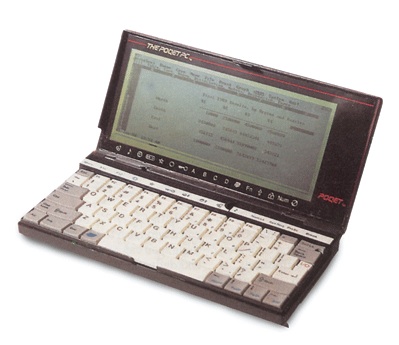DOS Palmtop: Poqet PC Classic Details and specs
Poqet PC Classic (Poqet PC)

About this machine:
The poqet PC - or "Poqet PC Classic" as we call it today to distinguish it from the later models - does not really deserve the title "first palmtop PC"
but most people would agree that it was the first useful one. It was originally just known as the "poqet PC", but shortly after its release the japanese
company Fujitsu tied contracts with Poqet Computer Corp. and later on completely purchased the company. Under their influence the successor "Poqet PC Prime"
was released and the original model renamed to "Poqet PC classic". If you have read my article about the DIP pocket PC and the Atari Portfolio you already
know that although it looks like a head-to-head race with the Atari portfolio the game was rigged from the start. What sounds like a conspiracy theory actually
really is one - from a certain point of view. All this can be explained with one of the creative heads behind the computer - Ian Cullimore - a british
developer and computer scientist who was not only one of the founders and Vice President of "Poqet Computer Corp." - manufacturer of the Poqet PC - but also
founder and main inventor of "Pocket PC" or later known as "dip" - manufacturer of the dip pocket computer aka Atari Portfolio. So while it looks like dip pocket pc,
Atari portfolio and Poqet PC were all competitors they were actually all children of Mr. Cullimore. However the Poqet PC - or rather "Poqet PC classic" as
we would refer to it today - was the first DOS based palmtop to feature full monochrome CGA resolution graphics - thus enabling the user to run most
CGA based DOS applications and games. Biggest drawback of the design is probably the proprietary expansion port on the back, so without a special serial parallel or
floppy cable you can not connect anything to the machine. However, back in the days the only obvious drawback was probably the price tag of 2000 USD.
Well another drawback is probably that this is the only palmtop i know that has a PC speaker which is not fully compliant to PC speaker standard. Don't ask me for
technical explanations but most games have issues with it. On many the sound is too slow, too low volume or otherwise distorted. Still this machine is
the one that set the mark and for most other DOS based palmtops you can somehow agree that they are kinda copy of this classic.
Specs:
CPU: 80C88 @ 7 MHz
Graphics: Monochrome CGA, 80 x 25 character MDA text mode, CGA 2 color monochrome graphics mode
Display: 640 x 200 monochrome DSTN , 4 grey scales, 4.8 inch
Memory (RAM): 512 KB
ROM (Software): 768 KB
I/O ports: 2 x Type I PCMCIA slots, Proprietary expansion connector port (Serial, parallel, Floppy drive etc can be connected through this)
Sound: PC Speaker - Piezo
Operating System: MS-DOS 3.3
Software: Poqet Tools, Poqet Link
Size: Length 11cm, Width 22cm, Height 2.5cm (4.3 inches x 8.8 inches x 1 inch)
Powered by: 2 AA batteries or AC adaptor (optional accessory), CR2032 Lithium button cell as memory backup
Weight: 540 gram (1.2 lb) including 2 standard AA and CR2032 batteries
Special features: RAM can be configured as additional RAMDISK space for saving user files.
Released: August 1989
Originally retailed for:: 2000 USD
Clone of: Not a clone.
Similar models: Poqet PC Prime, Poqet PC Plus
Pros:
- Outstanding battery life
- Fully CGA compliant, so most CGA based DOS appz and games work
- Large keyboard
Cons:
- Performs rather slow
- Low RAM, even less if you use a RAMdisk
- Not much useful software on ROM
- PCMCIA Type 1 slot only accepts obscure SRAM memory cards and a few rare modems
Collector Value:
5 of 10
Usage Value:
4 of 10
Verdict:
Give it a usability value of 10/10 if the built-in appz are all you ever need. Although this is a fully CGA compliant palmtop
it is rather large compared to the HP series, has only a proprietary I/O connector, it performs a bit slow and it has extrmely small memory.
Still it is impressive if you regard this is the oldest CGA palmtop. Many games and appz should work on it, but due to the low RAM not all
of them might be a pleasure. Sounds are often distorted. The power saving and battery running time is amazing but result in a somewhat slow performance sometimes.
The built-in appz definitely belong to the weaker ones. Very basic spreadsheet, notepad and phonebook. Not really great but might be "good enough" for many people.
Collector value is average - this is one of the more common palmtops but still not one you see on ebay every day. The keyboard outperforms the
HP line but otherwise this is technically the weaker version if you disregard the 95LX. If it wasn't the "first CGA compatible" palmtop it
would just be a "below average" palmtop, but at least it is somewhat collectable (although not really "rare").
Extras (Manual, downloads, etc)
Back to the Palmtop PC index
